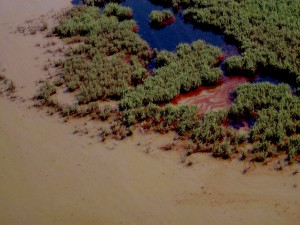The giant oil slick (reported to be the size of Puerto Rico) sliding around in the Gulf of Mexico like bacon grease on a George Foreman grill tied to the back of an alligator is once again sliming its way toward a Louisiana landfall. Latest predictions from the National Oceanic And Atmospheric Administration (NOAA) call for oil pushed by southeasterly winds to reach the marshes and barrier islands of Atchafalaya Bay by today (May 12.)
Media pundits from National Public Radio to Fox News that I listened to Saturday (5/9) seemed punch-drunk and dazed, their main concern appeared to be trying to determine if the word or words catastrophe and/or catastrophic applied to this unprecedented environmental disaster. The marshes, bays and coastal waters of Louisiana account for nearly 30 percent of all the country’s seafood harvest. Fishing, shrimping, oystering and crabbing from the Mississippi River to the Florida Panhandle have already been shut down and now those closures are moving west. Oil in some form has washed ashore from west of the Mississippi to Dauphin Island in Alabama.
Louisiana’s 8-million acre coastline composes 40 percent of all the nation’s coastal wetlands creating estuaries and nurseries and rookeries for thousands of species of commercial and sports fishes, marine mammals, birds, turtles and shellfish. More than 170 species of marine animals have been documented at a single oyster reef in the Gulf. When BP’s (British Petroleum) “black gold” seeps into these soggy shelters it becomes “black death” and the question becomes not, is this a catastrophe but what is the scope of this catastrophe and how long will the deleterious effects linger?
Twenty-one years after Exxon’s “black death” from the Valdez oozed ashore in Prince William Sound, it’s estimated that more than 20,000 gallons of the crude remain on some of the beaches. And while industry, corporate and political spokespersons are quick to try and gauge human catastrophe by dollar signs a study from the Exxon Valdez Oil Spill Trustee Council noted that alcoholism, suicide and domestic violence rates all rose in hard-hit communities following the Valdez spill. And even though the oil is just now skimming the Gulf coastal marshes, beaches and barrier islands, NOAA has already closed 10,807 square miles of Gulf to shrimpers and fishermen. Try telling one of them that losing their livelihood is not catastrophic.
And the breadth of human greed and complacency responsible for this catastrophe is tragic, in itself. As we watch BP floundering around in the Gulf unable to contain the flow of oil it is apparent they are clutching at straws while waiting for a relief well (the only tried and true technology to corral the blow out) that will take months to drill. Despite statements in it’s 2009 exploration plan that the type of catastrophe presently occurring in the Gulf was virtually impossible and that they were totally confident in their ability to handle any emergency, it is clear that BP was and is unprepared to respond to this type of event.
And while it would be easy to make BP the whipping boy – their drilling technology and protocol certainly meet U. S. industry standards across the board. And that’s the scary part.
Hopefully the chorus of “Drill baby, drill” will be replaced by “Stop, in the name of love.” Because, face it, until the energy picture changes significantly, domestic oil is going to continue to play a major part and as rigs steam into deeper and deeper waters chances of a repeat will only grow greater unless stricter safety regulations are put into place and enforced.

